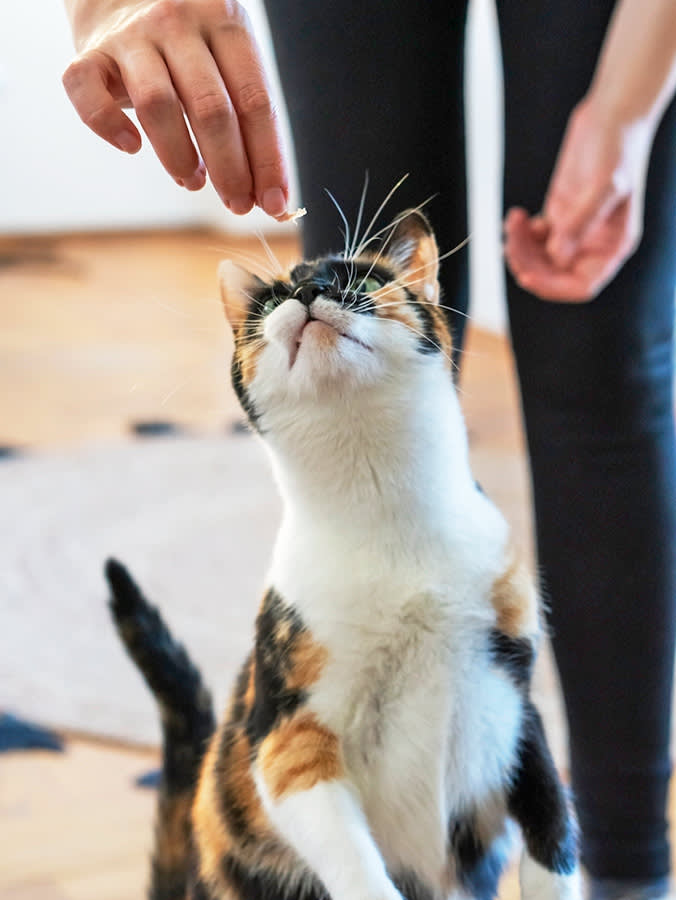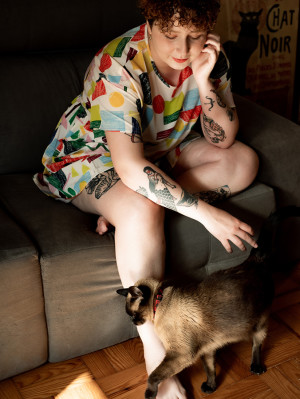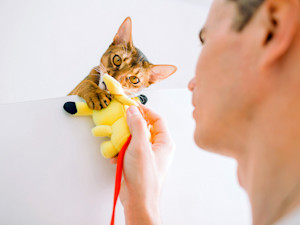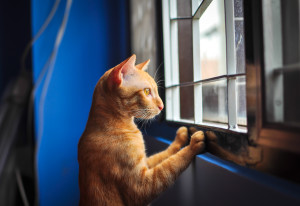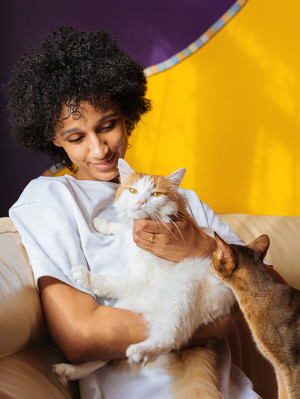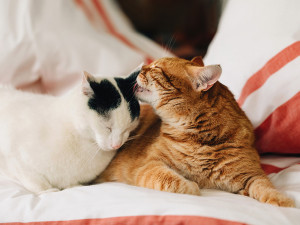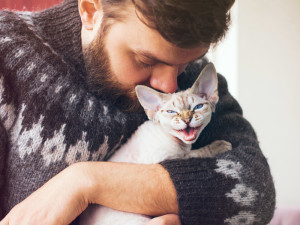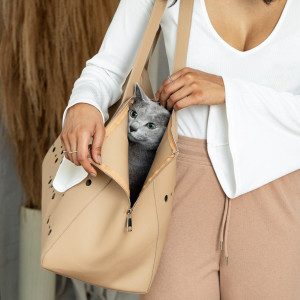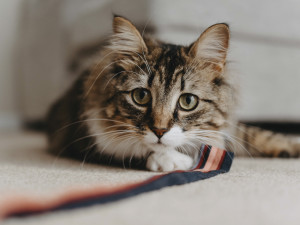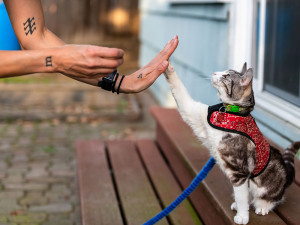The Secret to Persuading Your Cat to Do (Almost) Anything
Work with your cat and not against them
From grooming to vet visits, handling and routine care can be stressful for cats and their guardians. Using traditional methods of force and restraint such as scruffing causes cats to experience fear and anxiety, and can damage the relationship between a cat and their caregiver. Thankfully, it’s possible to take a gentler and more humane approach by introducing cooperative care training.
What is cooperative care training?
Cooperative care training is a consent-based method of interacting with cats. It involves actively training behaviours that make it easier for cat parents and veterinary professionals to provide husbandry and veterinary care without causing fear, anxiety or stress in your kitty.
It empowers cats to not just tolerate handling and routine procedures but also to collaborate with their caregivers, becoming active and willing participants in their care. Unlike traditional methods, which typically focus on humans taking control to get the task done as quickly as possible whatever the consequences, cooperative care prioritises the cat’s mental and emotional well-being.
The emotional benefits of cooperative care training (for cats and parents)
Have you ever felt vulnerable and anxious sitting in the dentist’s chair? Your dentist might have eased your fears by giving you a stop signal to use if you were in pain or needed a break. Having a stop signal makes us feel in control of a situation and that reassurance can be invaluable when it comes to us being willing to go through with a potentially aversive procedure.
The goal of cooperative care training is to give cats this same perceived sense of choice and control, helping them to feel safe, increasing their confidence, building trust, and reducing stress and the risk of associated medical conditions (did you know stress cystitis was a thing?). By allowing cats to opt in or out of your interactions with them, their anxiety decreases and they learn that they have nothing to fear. As their confidence in their environment and interactions with their parent or caregivers grows, they become calmer and more relaxed. Learning that their caregivers won’t force them into situations that are scary or cause them discomfort strengthens the cat-human bond, and makes cats more willing to cooperate in the future.
This can be useful in so many situations. For instance: pet parents may feel guilty and stressed if they have to force their cat into a carrier for a trip to the vet or physically restrain them to clip their nails or administer a worming pill. Navigating traffic whilst driving your car is distressing enough without having to hear your beloved companion yowling in the back – even if it is for their own good. Some cat parents face anxiety if their cat has a history of scratching and biting in defence when they feel threatened.
Cooperative care removes the need for force or coercion, resulting in less guilt and frustration and making handling safer, reducing the risk of injury to the cat and their caregivers. Instead, cat parents feel empowered with the knowledge and techniques to help their cat change negative, protective emotions to positive, engaging ones.
What can cooperative care training help with?
Cooperative care training can help cats become comfortable with all those things you think your cat will absolutely hate: grooming, nail clipping, toothbrushing and more. In fact, it might actually turn these activities into pleasurable bonding experiences rather than something to fear.
Most cats resist veterinary examinations, invasive procedures such as blood tests, and being medicated. With cooperative care training, they can learn to calmly accept handling, manipulation of their body parts and the administration of tablets, liquid medicines, eye and ear drops, creams, spot-on treatments and injectables, such as insulin or routine vaccinations.
Start by desensitising your cat to aspects of the examination that cause anxiety, introducing them gradually, eg, gentle touching of sensitive areas, such as paws, mouth and ears, or showing them the medication without attempting to apply it.
Reward calm behaviour with treats and praise. You can then slowly build up to replicate experiences such as having the skin of their scruff tented for vaccination, their mouth being opened to examine their teeth, their head raised to facilitate a blood draw, or the ear drops applicator nozzle being inserted into the ear canal.
Household items can be used to simulate medical equipment like the back of a metal spoon held against the chest to mimic the sensation of a stethoscope. If they don’t cooperate, never punish or reprimand them, instead, stop immediately and assess the environment for any potential stressors. Break the training down into smaller steps and revisit behaviours your cat is already comfortable with to help build their confidence.
The stress of visits to the vet often begins long before a cat arrives at the practice. Getting them into their carrier is a common struggle and, worryingly, the 2024 Cats Protection Cats and Their Statsopens in new tab survey reports that of the 58 percent of pet parents who say that they do not visit the vet as often as they would like to, 26 percent state the reason is that it’s too stressful for their cat. Cooperative care training teaches cats to associate their carrier with positive experiences and be willing to enter voluntarily, making travel smoother and reducing stress for cats and their people.
How to start cooperative care training
Set your cat up for success by training in a familiar, calm, quiet environment where they feel safe and relaxed. Try to avoid distractions like other pets or an enticing view of pigeons out the window. Consistency and predictability are crucial when training cats because they help create a sense of security and build trust, making learning more effective.
When training is consistent – using the same cues, rewards and timing – it helps cats understand exactly what is expected of them, reducing confusion and anxiety. Predictability ensures that cats can anticipate the outcome of their actions, reinforcing positive behaviours. It allows them to learn faster and remain engaged, while inconsistent training can cause frustration or stress.
Cooperative care training is taught using positive reinforcement, reinforcing desired behaviour with rewards. Counterconditioning can be used to pair potentially stressful activities with positive experiences, gradually changing your cat’s emotional response from anxiety and fear, to calm engagement.
Desensitisation can be used to introduce your cat to procedures in small, manageable steps, starting with low-intensity exposure and gradually increasing this, allowing them to grow in confidence. For example, train cooperative nail clippingopens in new tab in stages, gradually working up to clipping all nails in one session. Always end training on a positive note to maintain your cat’s enjoyment and willingness to participate.
An exercise to try
Teaching your cat to lie on a mat is a foundational behaviour with many uses. It can promote calm behaviour and relaxation. It is incompatible with undesirable, potentially dangerous behaviours such as door-dashingopens in new tab. It can be used to encourage a cat to voluntarily sit on weighing scales or as the first stage of carrier trainingopens in new tab.
Sitting or lying on a mat can also be what’s known as a ‘start button’ behaviour, a behaviour that communicates they are ready to proceed and consent to being groomed, examined or medicated. If they step off the mat, it’s a clear signal that they are withdrawing that consent.
Start by placing a non-slip mat in a quiet, familiar area and let your cat investigate it. As soon as they approach it, say a marker word like ‘yes’, or give a tongue click, and reward them with a treat. After a few repetitions, wait until they place a paw on the mat before marking and rewarding (toss the treat away from the mat to reset their position, ready for another go).
Gradually raise the criteria to two paws on the mat, followed by all four paws, then sitting, and finally, lying down and relaxing, continuing to mark and reward the desired behaviour at each stage so your cat knows which behaviour is being reinforced and will be more likely to repeat it. Once they consistently go to the mat as soon you place it down, add a verbal cue like ‘on your mat’, just before they step onto it.
Signs of stress and when to stop
A key aspect of cooperative care training is that the cat is allowed to say no through their behaviour or body language. If they are engaging with a food treat or toy, it’s a yes but if they disengage, they are communicating that they are uncomfortable and need to take a break.
Cats may experience internal conflict if they desire the reinforcer but simultaneously find what they are being asked to do too aversive, so be alert to subtle changes in body language, such as tongue flicking, lip licking, yawning, body tension, tail swishing, flattened ears and pupil dilation, and stop immediately if you witness any of these signs of discomfort, even if they are still eating treats. The onus is on caregivers to constantly question whether the cat is ok and if they aren’t, to determine what can be done to change that.
Cooperative care training should be a goal for all cat guardians, but training takes time. It’s important to recognise that there may be some situations where gentle control, such as towel wrapping or sedation, is required, for instance, in an emergency where a cat’s health or welfare depends on a pet parent or veterinary professionals taking immediate action.
Tools for cooperative care training
Many people believe that cats will only work for food. While most cats are strongly motivated by food treats, others find playing with a favourite toy, facial rubbing on a grooming mitt or being petted more rewarding. Determining their preferences will help you tailor your reinforcers effectively. You may not be able to deliver this primary reinforcer the instant your cat performs the desired behaviour, so use a tongue click, or word to mark the behaviour being rewarded and indicate that reinforcement is imminent.
Target training is incredibly useful for cooperative care, as it allows you to direct your cat’s movement without force and gives them something to focus on, which helps them to remain still and feel in control, reducing anxiety and stress. You can use your hand or a target stick, (a chopstick with a ping pong ball on the end works well), marking and rewarding your cat when they touch it with their nose, paw or another body part and gradually increasing the duration.
Debunking the myths about cat training
If you’re familiar with the idiom ‘like herding cats’, you’ll know that felines have a reputation for being independent, stubborn and untrainable, but this is completely unwarranted. Cats can learn a wide range of cooperative care behaviours through positive reinforcement training. However, to succeed, it’s crucial to approach their training with an understanding of their species-specific needs, for example, cats have short attention spans, so two or three five-minute sessions a day will be more effective than one long session.
It’s a common misconception that cats get bored easily. They tend to lack motivation because it’s taking them too long to eat each treat, decreasing momentum and reducing the rate of reinforcement, or the reinforcer isn’t rewarding enough. For example, cats have much smaller stomachs than dogs, so food reinforcers must be broken into tiny pieces to prevent them from feeling full too quickly.
They say, “you can’t teach an old dog new tricks”, but that’s certainly not the case with cats. Cooperative care training can be particularly beneficial for senior cats who are more likely to require ongoing treatment for chronic conditions such as hyperthyroidism, osteoarthritis, diabetes and kidney disease. Though they might require slower-paced training sessions than younger learners.
